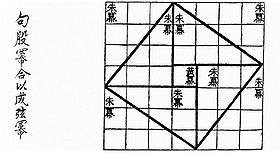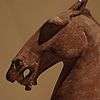Zhoubi Suanjing
The Zhoubi Suanjing (Chinese: 周髀算經; Wade–Giles: Chou Pi Suan Ching) is one of the oldest Chinese mathematical texts. "Zhou" refers to the ancient Zhou dynasty (1046–256 BCE); "Bi" means thigh and according to the book, it refers to the gnomon of the sundial. The book is dedicated to astronomical observation and calculation. "Suan Jing" or "classic of arithmetics" were appended in later time to honor the achievement of the book in mathematics.

This book dates from the period of the Zhou dynasty, yet its compilation and addition of materials continued into the Han dynasty (202 BCE–220 CE). It is an anonymous collection of 246 problems encountered by the Duke of Zhou and his astronomer and mathematician, Shang Gao. Each question has stated their numerical answer and corresponding arithmetic algorithm. This book also contains one of the first recorded proofs of the Pythagorean Theorem.
Commentators such as Liu Hui (263 CE), Zu Gengzhi (early sixth century), Li Chunfeng (602–670 CE) and Yang Hui (1270 CE) have expanded on this text.
Background behind Pythagorean derivation
At this early point in Chinese history the model of the ancient Chinese equivalent of Heaven, 天 Tian, was symbolized as a circle and the earth was symbolized as a square. In order to make this concept easily understood the adopted symbol of the heavens was the ancient Chinese chariot. The charioteer would stand in the square body of the vehicle and a "canopy", the equivalent of an umbrella, stood next to them. The world was thus likened to the chariot in that the earth, the square, was where the charioteer stood, and heaven, the circle, was suspended above them. The concept has thus been termed "Canopy Heaven", 蓋天 (Gaitian).[1]
Eventually the populace began to turn away from the "Canopy Heaven" concept in favor of the concept termed "Spherical Heaven", 渾天 (Huntian). This was partly due to the fact that the people were having trouble accepting heaven's encompassment of the earth in the fashion of a chariot canopy because the corners of the chariot were themselves relatively uncovered.[2] In contrast, "Spherical Heaven", Huntian, has Heaven, Tian, completely surrounding and containing the Earth and was therefore more appealing. Despite this switch in popularity, supporters of the Gaitian "Canopy Heaven" model continued to delve into the planar relationship between the circle and square as they were significant in symbology. In their investigation of the geometric relationship between circles circumscribed by squares and squares circumscribed by circles the author of the Zhoubi Suanjing deduced one instance of what today is known as the Pythagorean Theorem.[3]
See also
References
Citations
- Tseng (2011), pp. 45–49.
- Tseng (2011), p. 50.
- Tseng (2011), p. 51.
Works Cited
- Boyer, Carl B., A History of Mathematics, John Wiley & Sons, Inc., 2nd edition, (1991). ISBN 0-471-54397-7.
- Tseng, Lillian Lan-ying (2011). Picturing Heaven In Early China. Harvard East Asian Monographs (1st ed.). Cambridge: The Harvard University Asia Center. ISBN 978-0-674-06069-2.CS1 maint: ref=harv (link)
External links
- Full text of the Zhoubi Suanjing, including diagrams - Chinese Text Project.
- Full text of the Zhoubi Suanjing, at Project Gutenberg
- Christopher Cullen. Astronomy and Mathematics in Ancient China: The 'Zhou Bi Suan Jing', Cambridge University Press, 2007. ISBN 0521035376
